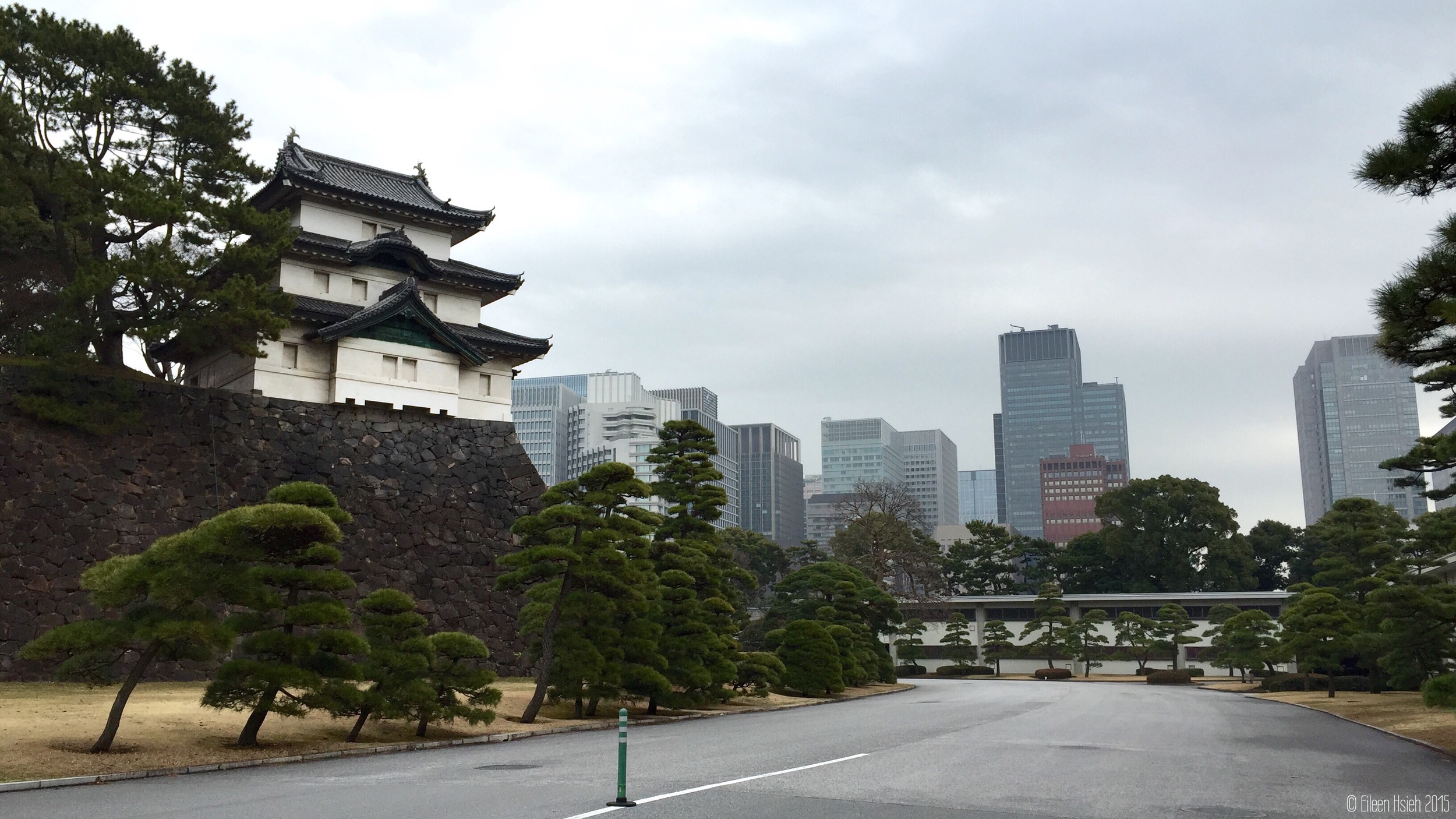Behind the Gates: Tokyo Imperial Palace | 與皇宮有約 : 春遊東京皇居
文:筱晴, Eileen Hsieh / 圖:Eileen Hsieh
Planning is essential for anyone who wants to travel efficiently and economically in Japan, from purchasing the JR Rail Pass before leaving your home country, to reserving a spot online for the free guided tours of the Imperial Palaces in Kyoto and Tokyo. (See the end of the article for guidelines.)
遊玩日本,大部分的名勝古跡只需買票就能進場參觀,但是王室所擁有的皇宮平常不對外開放,所以旅客們必須先到王室官方網站上預位,才有機會免費跟隨著專業嚮導遊覽宮殿內部。
我們選擇了兩座皇宮,一是有千年歷史的京都御所,一是現在天皇居住的東京皇宮。(預票方法請看文章下方。)
The Imperial Palace in Tokyo
Last year we thoroughly enjoyed our visit to the East Garden of the Imperial Palace, which is open the the public. This year we wanted a closer view of the residence of the Emperor, so we went on the Imperial Household Agency website and reserved a guided tour.
東京皇居
在東京,我們選擇住 Palace Hotel,為的是接近皇居。從房間大片落地窗看出去,護城河,宮殿飛簷,綠意盎然的庭園,呈現眼前,原來皇宮就在咫尺。
我們預約早上十點的那一場,有專人導覽。
The Imperial Palace in Tokyo is built on the site of the old Edo Castle dating back to the 15th century, which originally covered a much larger area stretching as far as the present day Tokyo Station. It has served as the main residence of the Imperial Family since 1869.
Today, the lush castle grounds featuring Edo Period stone walls and moat occupy approximately 390 acres of prime real estate, making the Imperial Palace a popular outdoor space in the city.
東京皇宮是江戶時代,德川歷代將軍的居城,周圍環繞著護城河,四周建有八個門。明治維新後,明治天皇把京都御所遷都到這裡,從此以後,便成了天皇居住的所在。昭和20年(1945),明治宮殿被燒毀,昭和43年(1968),現在的宮殿落成啟用,算是歷史短暫的皇居。
眾所周知,東京地下鐵網路綿密,但位在東京都市中心的皇宮,卻沒有一條鐵道穿過皇居底下。皇宮面積約115萬平方米,一大片綠地,猶如都市之肺,是市民最佳的休閒去處。
The East Garden is open to the public almost all year round, but the inner grounds of the palace are only open to visitors on January 2 (New Year's greeting) and December 23, when the Emperor celebrates his birthday.
皇居的大部份地方均不對外開放,只有皇居東御苑及外苑公園開放給遊客參觀。皇居內部每年只開放兩次,分別在天皇誕生日及新年次日(1月2日),屆時民眾攜老扶幼,來為天皇拜壽。
The tour route covers the main buildings of the palace including:
Fujimi-yagura Keep: Reconstructed in 1959 after a fire, this three-story keep is perched high on a stone wall with view of Mount Fuji.
The Imperial Household Agency building: Constructed in 1935, the building was used as the temporary Imperial Palace for some years after World War II.
參觀路線可看到主要的建築物有:
「富士見櫓」: 是江戶城的遺跡中最為古老的三層櫓樓。被火燒毀後於1659年重建,石牆高度14.5米,櫓樓高度 15.5 米,聳立在皇宮高處,數百年來,守護著江戶城。
「宮內廳廳舍」: 建於1935年,戰後(1952-1969),作為臨時宮殿使用。
The Palace Complex: Several steel-framed reinforced concrete structures built in 1968.
Chōwaden Reception Hall: Where the Emperor and Empress delivers new year and birthday greetings to the public.
Fujimi-tamon defence house & Hasuikebori lotus moat: Surrounded by the moat, the stunning Fujimi-tamon serves both defensive and decorative purposes.
Nijubashi: Formally known as Seimon Ishibashi, the picturesque double arch bridge is the official entrance to the palace.
Fushimi-yagura: The two-story keep once stood on the grounds of Fushimi Castle in Kyoto and had been dismantled and reassembled here.
「宮殿」:1968年建成,由天皇辦公的表御座所,豐明殿,長和殿所構成的鋼筋混凝土建築物,也是舉辦各種儀式與慶典活動的正殿。
「長和殿」:新年及天皇誕辰時,以天皇與皇后為首的皇族,在此接受眾人的祝賀,並由天皇致辭。
「富士見多聞」,「蓮池濠」: 建在石牆上面的多聞,兼具防禦和裝飾功能,也是櫓樓的一種,還有實際用途,如作為倉庫或武器庫等。石牆下便是蓮池濠,夏天可賞蓮荷。
「正門鐵橋」(二重橋)與「伏見櫓」: 正門鐵橋被通稱為二重橋,半圓弧的橋拱,倒映水中,形成一圈完美的圓,是熱門的拍照地點。伏見櫓據說是在三代將軍家光時期,從京都,伏見城遷移過來的。
以上幾處,是需要預約參觀的。但皇宮東御苑內的建築物,則可自由參觀。
Edo Castle Ruin: All we see now is the foundation of the former castle tower, which had been the tallest in Japan upon completion in 1638. Sadly it was destroyed by fires in 1657 and never rebuilt.
Tokagakudo: The "peach blossom" music hall was completed in 1966 in commemoration of Empress Kojun's 60th birthday.
「江戶城天守閣遺跡」:江戶城的天守閣完建於1638年,當時城牆高度約14米,上面聳立著日本最大的天守閣。在1657年,一場大火燒毀後,就不再重建,只留下作為基的石牆。上去石牆最高處,整個空蕩蕩的,可瞭望東京的摩天大樓。
「桃華樂堂」: 1966年,為了紀念香淳皇后六十大壽而建的音樂堂。
Ninomaru Garden: Japanese garden found in the secondary circle of defence of the Palace.
Museum of the Imperial Collections: Showcasing some of the Imperial Household's treasures. Admission free.
「二之丸庭園」:還原江戶時代的回游式庭園風貌,花團錦簇,春意濃郁。
「三之丸尚藏館」:皇室捐出的美術工藝品,已收藏近萬件。
預約參觀時間程序 Tour Reservation Guidelines
1. 請到日本宮內廳事務所(日/英版)。
Visit the website of Imperial Household Agency (available in Japanese and English).
http://sankan.kunaicho.go.jp/english
2. 請按位於頁面右上方的「Application For Visit」(參觀申請)。
Click on the "Application For Visit" button on top right of the page
3. 請選擇第一個框框 -「參觀申請」。
Click on the first box on the page - "Application For Visit"
4. 請選擇「皇居」。
Select "The Imperial Palace in Tokyo"
5. 請選擇導遊解說語言與遊覽時間長度。
Choose preferred language and length of the tour.
6. 請選擇首選參觀月份。
Choose the preferred month for your visit.
7. 請選擇首選日期與時間(藍色代表還有空位)。
Choose the preferred Date & Time for your visit (only the times in BLUE are available)
8. 請填寫申請人訊息表格。
Fill out the applicant details form.
9. 請選擇是要現在就填寫訪問成員的個人訊息,還是以後再填寫。
You can choose to enter visiting member's details now ("Type Member's Information") or upload them later ("Edit Member's Information and Upload Later")
10. 申請完成!去京都御所前記得要把申請證明email打印出來,還要帶護照喔!
Application complete! Don't forget to print out the confirmation email and BRING YOUR PASSPORT!


